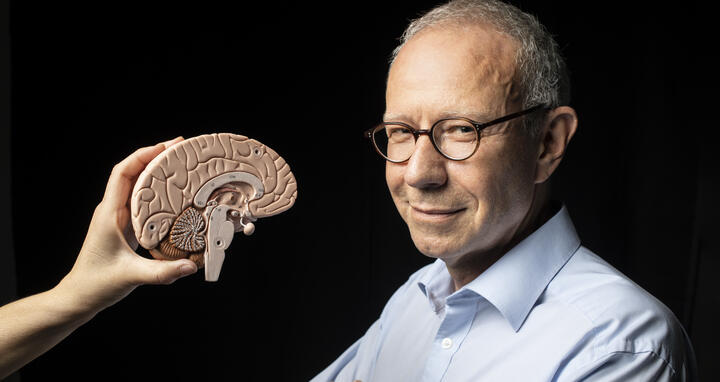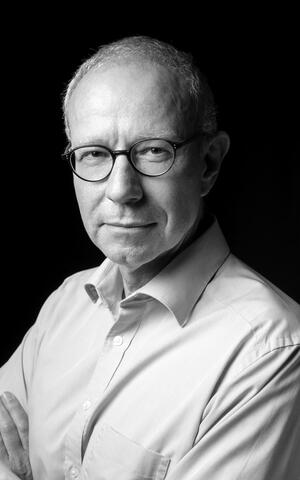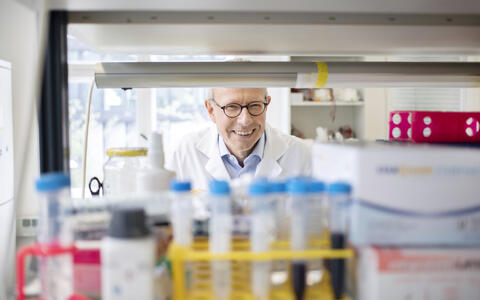A strategist in lipid metabolism
“This is what it looks like in the brain,” says Thomas Willnow. He points to his screen, which is sitting on a large desk that has been cleared of papers and any other distractions. This orderly environment helps him to make headway in his quest to understand more about the underlying causes of Alzheimer’s disease, which affects around 700,000 people in Germany alone and makes the aging brain shrink like a grape that has been left out in the sun too long. “Up to 30 percent of the brain mass has simply disappeared,” says Willnow. “This is the moment when there is nothing more we can do in terms of treatment.”
I rarely look back and am always searching for the answer to the next question.
Thomas Willnow heads the Molecular Cardiovascular Research Lab at the Max Delbrück Center for Molecular Medicine (MDC). This field of research has more to do with Alzheimer’s than one might think, as disruptions in the body’s lipid metabolism are not only dangerous for the vessels of the heart; they are also a major risk factor for the death of neurons in the brain. As a cell biologist, Willnow wants to understand the molecular basis of lipid metabolism in the brain. He wants to find ways to treat pathological forgetfulness early on – long before the brain starts to resemble a shriveled raisin. And he is deeply committed to his work. “I am an impatient person,” Willnow admits. “I rarely look back and am always searching for the answer to the next question.”
A big question in Alzheimer’s research
Willnow opens a drawer and takes out a plastic model of a brain – split in two and demonstration-ready. This is one of the props he uses to explain his research to laypersons. It is here, he explains, in the entorhinal cortex, a central region of the brain that controls emotions and memory, that the problems begin – the plaques, which then gradually attack the surrounding areas of the cerebral cortex.
He pulls a stack of paper from the printer and sketches a neuron on the top sheet – a pentagonal shape with long, spidery projections called axons, at the end of which are synapses. This is how the cell communicates, forms networks, and makes the brain what it is: a miracle of evolution. “In Alzheimer’s, these axons retreat and the neurons atrophy,” explains Willnow. The reason for this is cellular stress, which can be caused by diabetes, high blood pressure, obesity, epilepsy or inflammation. The result is the dreaded plaques – protein fragments that are deposited between the neurons and disrupt their function.
Willnow is also affiliated with Charité – Universitätsmedizin Berlin and Aarhus University.
“To form healthy axons and synapses, neurons need omega-3 fatty acids, among other things,” explains Willnow. “They convert these into endocannabinoids to protect themselves against inflammation.” The scientist takes another sheet of paper and draws a pentagonal astrocyte, a type of cell in the brain supplies neurons with omega-3 fatty acids. To do this, it combines the lipids with a transport particle called apolipoprotein E (ApoE) – which, in Willnow’s sketch, resembles a circle with many small fat globules. ApoE docks to a receptor on the neuron called sortilin. The cell membrane invaginates, forming a pocket with both transport particle and receptor inside, which then pinches off into a vesicle so the precious cargo can be delivered to the interior of the cell. “The receptor shovels ApoE into the cell at a rate of about six times per hour,” says Willnow. The receptor sortilin therefore works a bit like a lipid metabolism excavator in the brain. In Alzheimer’s, the function of this excavator is impaired. As a result, there is a lack of endocannabinoids and the neuron enters a state of permanent stress. But why exactly does this process come to a standstill? “This is an important question in the development of new therapeutic approaches,” says Willnow.
“At some point it grinds to a halt”
With his research group, Willnow has found a possible answer to this question. As far back as 2013, he identified sortilin as the crucial receptor for ApoE transport particles in neurons. Earlier work by geneticists has also shown that about one in five people carries a particular variant of the ApoE gene that increases the risk of Alzheimer’s disease by a factor of 12: ApoE4. Using mice studies, Willnow’s research group has now been able to clarify why this is the case. This variant of the transport particle prevents the sortilin receptor from returning to the cell surface to continue shoveling after it has unloaded its cargo. Instead, it clumps up inside the cell. “Efficiency was reduced by about half in the mice with ApoE4, resulting in the cell constantly receiving too few omega-3 fatty acids and becoming more stressed,” says Willnow. “It’s like an excavator that has been poorly oiled for 50 years – at some point, it grinds to a halt.”
This discovery, published in 2020, represents an important step forward for Alzheimer’s research. But Thomas Willnow is not someone to boast of such successes. He is more interested in the process that leads to the success. He compares it to a game of chess. “If I want to understand and treat a disease mechanism, I need to know all the pieces of the game: the transport particle ApoE, where it comes from, where it goes, and how it gets there,” explains Willnow. “Only when I know all the pieces on the chessboard can I understand how they interact and what could go wrong.” And he has already planned his next move: He wants to close examine a number of newly discovered genes that effect lipid metabolism in the brain. Could, for example, a particular gene variant prevent the formation of the vesicles that carry the sortilin receptor and ApoE into the neuron?
A new dimension of the living world
It was the Grzimeks, Sielmanns and Cousteaus of his youth that awakened in Thomas Willnow a soft spot for nature – and the urge to understand it. He moved from Heidelberg to Munich to study biology, while also mapping biotopes for nature conservation organizations. But soon a new dimension of the living world opened up to him: that of molecules. “Ultimately, molecules explain everything – all the diversity of the living world as well as the problems we encounter,” says Willnow.
He decided to specialize in cell biology and study endocytosis, the process through which cells take in nutrients. As a postdoctoral fellow, he went to Joseph Goldstein and Michael Brown at the University of Texas Southwestern Medical Center in Dallas. These two physicians had received a Nobel Prize a few years earlier for their work on the importance of cholesterol metabolism. “That was a formative time for me,” says Willnow. “They had such a burning enthusiasm for their research and a will to fight their way through any challenges.”
Thomas Willnow has been studying the development of neurodegenerative diseases for many years at the MDC.
In 1996, a Heisenberg Scholarship from the German Research Foundation (DFG) enabled Willnow to set up a research group at the MDC. “At that time, Alzheimer’s research was becoming immensely important and I decided to apply my knowledge of cell biology to this field,” says Willnow. At that time, the MDC had only just been established. “The decision was a stroke of luck, as it quickly achieved a high international level of biomedical research.” His love for nature, however, still remains. He often travels with his wife and sons, all biologists themselves, to Africa or America to see the animals from the TV documentaries of his youth. It is only there, in the wilderness, that he can really switch off.
The next chess move
Thomas Willnow always has one goal in mind: To create useful knowledge and identify molecular target structures for therapies. During his time at the MDC, he has already founded two spin-off companies for the development of drugs designed to block specific receptors that trigger neuron death in dementia or strokes.
He has now also set up a new research group in Aarhus, Denmark, which will be funded by the Novo Nordisk Foundation for a period of seven years. Here, he wants to develop prototypes for Alzheimer’s medication. “The most direct approach would be, for example, to oil the excavator more effectively so that more fat gets into the cells,” he explains. “We want to stop ApoE4 from causing the sortilin receptor to clump up.”
The impatience with which he pursues his research is also the result of time pressure. “Alzheimer’s and other forms of dementia are becoming a serious problem in our aging society,” says Willnow. So far, treating the disease in its later stages has proved unsuccessful. There is therefore urgent need for knowledge of all the known and not-yet-known pieces on the molecular chessboard so that scientists like Willnow can get a head start. And, of course, plan the next move.
Text: Mirco Lomoth








